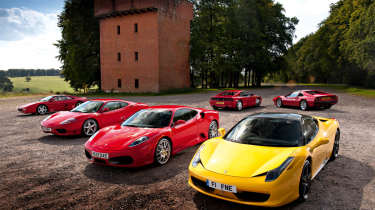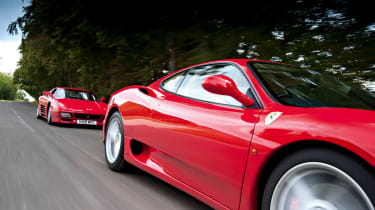Ferrari 458 Italia meets 308, 348, F355, 360 and F430 - Ferrari 360 Modena
Hi-tech 458 Italia meets its 308, 348, F355, 360 and F430 ancestors in a sonorous supercar group test
Fly-off handbrake on, lift up the flap to open the door (a system that appears from 348 all the way through to 458) and lunchtime finds me standing at a crossroads in the Ferrari V8 story: behind are buttresses and slats, ahead lie crackle-finished red cam covers beneath curvaceous glass. The 360 Modena really couldn’t look much more different to the 355 if it tried, and its design attracted some criticism at the time. I think it’s aged well, though, and the simplicity of both the 355’s and the 360’s lines makes them amongst the most seductive here.
Inside the 360, things have changed as much as on the outside. You feel like you’re sitting more upright and slightly higher off the ground. The steering wheel sits more vertically, the prancing horse in its centre pointing at the top of your six-pack rather than the middle of your sternum. The cockpit feels tidier, too, now that the instruments have all migrated back under the main binnacle with the rev-counter taking centre stage.
Despite being a noticeably bigger car, the 360’s weight is on a par with the 355’s thanks to an aluminium spaceframe replacing steel box-section in the chassis. You can sense the increase in stiffness just rolling across the larger stones in the car park, with the whole car feeling tighter, stiffer and more honed. With the slightly sparse interior, and the whole bodyshell reacting to what’s underneath the Pirelli P Zeros, it’s a bit like sitting in a big Lotus Exige.
The 360 was the last V8 Ferrari to sell in any meaningful numbers with a manual gearbox, so I’m quite pleased that this one doesn’t have paddles. The open-gated manual is a revered thing – it’s like one of the seven wonders of the automotive world, along with a Lamborghini scissor door and the McLaren F1’s central driving position. But the truth is that, as the 348 showed, they can sometimes be a complete pig to use, particularly when the oil’s chilly.
When they’re working well (say, in an Audi R8… I’m going to find a prancing horse’s head in my bed for saying that!) you get the delicious clack-clack as the shaft moves swiftly between the prongs and it feels as smooth and satisfying as sliding a garden spade into soft earth. The 360’s is the best of the manual shifts here, with an easy, well-oiled action, even if occasionally it throws up a little unexpected resistance. It’s a characterful challenge – and I still love it.
The 360 is the first car I’ve driven today that feels like a junior supercar in terms of its straight-line pace. Perhaps it’s because it’s rawer than the 355, but the increase in punch feels greater than the 20bhp hike and 0.2sec drop in 0-62mph time would suggest.
I find myself chasing Harry in the 348 and I watch as the black-slatted rear dives into a third-gear left-hander. The 360 follows with ease, obviously, but it feels like the tyres are barely scratching the surface of the road rather than digging in and generating huge grip. The quick steering and reactive nose mean it feels very much like the precursor to the 430 and 458 that it is, but when grip runs out at the front there’s a mid-engined twitchiness to the balance that you don’t feel you necessarily want to provoke.
Written down, it sounds a bit like the 348’s handling traits might have skipped a generation, but in reality there’s a much lighter, more tip-toey sensation with the 360. It’s more like a big mk1 Elise and delightful in the same way, but there’s an edginess that means you can’t drive it with quite the abandon of the cars that succeeded it. Nevertheless, it’s interesting how acutely you can feel the genesis of the current 458’s handling.





